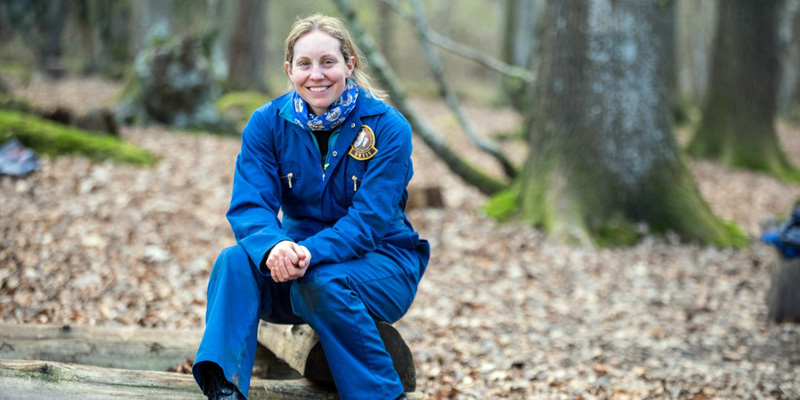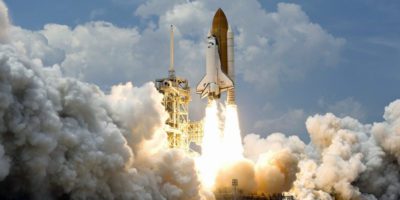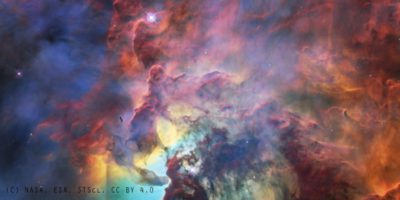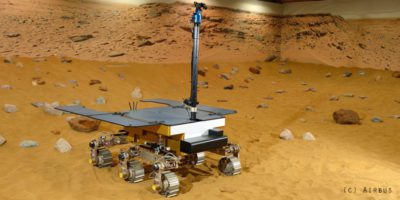Dr. Suzie Imber is an Associate Professor in Space Physics at the University of Leicester, where her main research interest is the study of the interaction of the solar wind with the planetary magnetospheres of the Earth and Mercury. In 2017, Suzie was selected as one of 12 contestants on the BBC2 series, Astronauts: Do You Have What It Takes?, which she went on to win. She studied for her undergraduate degree at Imperial College London, before moving to the University of Leicester for her Doctor of Philosophy, titled ‘Auroral and Ionospheric Flow Measurements of Magnetopause Reconnection during Intervals of Northward Interplanetary Magnetic Field’.
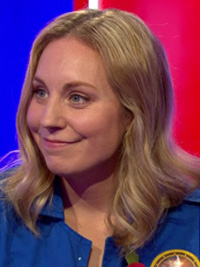
“…The experience taught me that I should have more faith in myself…”
Space – there’s no subject like it!
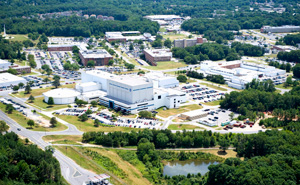
I studied a four-year master’s degree in physics at Imperial College, London, and found myself interested in space science. During my undergraduate degree, I applied for an internship at NASA, and was fortunate enough to spend two summers working at NASA Goddard Space Flight Center, near Washington DC.
These summers inspired me to continue studying space science and I did a Ph.D. at the University of Leicester, which has a world-leading space physics research group. I then went to NASA as a research scientist, working there for three years, before returning to Leicester to take up a permanent position.
I love working in space science because we’re always pushing the boundaries of our capabilities. We’re constructing spacecraft that go to new regions of the solar system, often having to overcome huge engineering and technical hurdles (extreme temperatures and radiation environments for example) and in doing so we solve the key gaps in our understanding of how our solar system works. There’s no subject like it!
My role
I am an Associate Professor of Planetary Science at the University of Leicester, so I have two main roles. I lead a research programme focusing on understanding the dynamics of the planet Mercury, particularly important as the European Space Agency’s BepiColombo spacecraft is heading to Mercury in October, with an instrument that we (at the University of Leicester) have designed and built.
I also contribute to the teaching that goes on the department, lecturing several undergraduate physics courses, and supervising master’s degree projects.
Finally, though, after Astronauts, I have done a lot of public engagement and outreach, and over a six-month period I have spoken with 20,000 young people at schools, astronomical societies, scouts, brownies and science fairs about how incredible it is to be a scientist, and how in the future, many ordinary people will have the opportunity to go into space.
In the future we will be launching spaceships from the UK & will be able to find out what Mercury is made of.
🚀Space scientist @SuzieImberSpace tells 6-year-old Rumaysa how the UK is leading on space exploration ahead of the GREAT Festival of Innovation. #GREATInnovation pic.twitter.com/8ya9oZslWQ— Department for International Trade (@tradegovuk) March 9, 2018
Here comes the sun
My research centres around the interaction of the Sun with the planets in our solar system. The Sun emits hot gas (plasma) all the time, and this travels through the solar system, interacting with each planet as it goes.
At Mercury, and at the Earth, this interaction drives a huge circulation of plasma and magnetic fields around the planetary body, imparting energy and momentum to the planetary system. This energy is stored in the magnetic field of the planet until it is released, explosively, and energy is transferred to particles which travel down magnetic field lines towards the planet.

At the Earth, these particles hit the upper atmosphere, causing it to glow, and generating the aurora borealis and australis (northern and southern lights). The Sun is a dynamic body, and solar activity waxes and wanes in an 11-year cycle. When the Sun is more active, the coupling between the solar wind and the Earth’s system is more efficient, and this can lead to disruption to the electronic systems on which we, as a society, depend.
These space weather events can cause power grids to fail, damage to spacecraft instrumentation, problems with GPS signals, radiation to astronauts outside the international space station and high frequency radio wave communication blackouts. We are working on understanding space weather at all planets in the solar system, to eventually allow us to predict space weather events in advance, and to mitigate against the harmful effects of space weather on our society on Earth.
Taking part in Astronauts: Do You Have What It Takes?
The Astronauts series was commissioned by the BBC with the aim of being both educational and inspirational. The idea was that we would start with 12 candidates (from many thousands of applicants) and those candidates would be put through a series of tests, akin to astronaut selection.
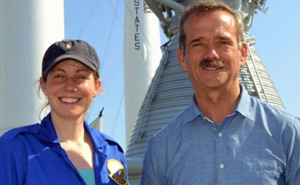
The judges were Commander Chris Hadfield (Canadian astronaut), Dr. Iya Whitely (psychologist), and Dr. Kevin Fong (doctor, specialising in extreme environment medicine). They would evaluate the candidates, and eliminate the weakest as the process developed, eventually ending up with one remaining candidate who would win the competition, meaning that they are the most capable of becoming an astronaut in the future.
The prize was a letter written by Chris Hadfield recommending that candidate next time the European Space Agency open up astronaut selection.
The importance of self-belief
The experience taught me that I should have more faith in myself. I went through the entire process expecting to be eliminated at every turn, convinced that I had performed less well than the others, when (upon seeing the show) I later realised that simply wasn’t the case, and at times I had outperformed the others while evaluating my performance as weaker.
This tendency toward overly criticising my performance was amplified by the fact that during the process we received no feedback during any of the tests, so it was difficult to judge how well we had done. Throughout the process, I was hoping I’d get as far as possible so that I could experience as many of the tests as possible. We were given the opportunity to have experiences that money can’t buy, and although the pressure was high, I didn’t want it to end!
It was a great surprise to me when my name was announced as the winner, as I was convinced it would not be me who won the show. Winning the show has given me a platform to a new area of work for me – public engagement. I now go to hundreds of schools and talk with the students about my career as a scientist, about overcoming fears and coping with failure, about making the most of the talents we have and working on our weaknesses to reach for our dreams.
I want to show them what it’s like to be a real scientist, and to dispel the myth that you have to be Einstein to have a career in science. I also want to show them that the space industry is growing massively and we need a whole range of expertise.
Public response
Initially I was a little worried about the public response to the show, as there were definitely tests that I completely failed, and I thought there may be some negative feedback on social media. Having said that, the style in which the series was produced and the professionalism of both the production team and the other candidates totally negated that fear.
The show was produced in a really positive manner and aimed to show the best that 12 ordinary people could achieve in a situation where we were being tested to our limits. It showed our weaknesses, but with a focus on improvement and on learning from our mistakes, and as a result the public were hugely supportive of the show.
I didn’t receive any negative comments, and instead lots of people contacted me to congratulate me on the show, on my achievement as the winner, and to find out what I’m doing next. The show has opened lots of new doors for me and given me opportunities that I never believed would be possible!
Why you should get involved in the space industry
I’m not one for giving advice, but from my experience I would highly recommend getting involved in the space industry. It’s a growing sector, and we’re going to need experts in all areas of work, as I mentioned earlier, from lawyers to business leaders, from journalists to architects. Of course, we also need scientists (like me), engineers, and technical experts in a range of fields.
We all rely on the space industry – it’s relevant to everything we do, from navigation to communication and the Internet, and from hazard warning to resource management and global monitoring.
Coming up next
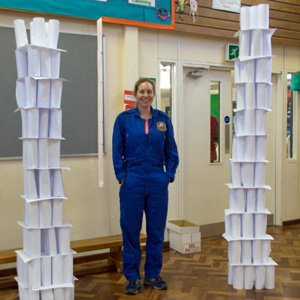
Since the show aired, I have spoken with over 20,000 students so far in their schools, as well as businesses and science festivals. The show gave me an incredible platform to encourage more young people into STEM, and particularly physics, and as long as that platform lasts, I want to continue this mission.
In terms of work, ESA’s BepiColombo mission is launching in October of this year (fingers crossed!) and I am involved in that mission, so that will be a busy time for me and the team at Leicester, as our instrument blasts off to Mercury. It’s a seven year wait until the spacecraft arrives, but we’re excited to see it start that journey.
I have had the chance to become involved with some commercial spaceflight organisations, and to do some more astronaut training myself. I’m delighted to have been invited to play a role in these exciting ventures which will lead to normal people being able to experience a trip to space, and particularly to be thinking about what training a passenger in space might require prior to their launch.
So, it’s a busy time ahead, but an exciting one, and I look forward to what’s around the corner!
https://www2.le.ac.uk/departments/physics/people/suzanneimber
https://twitter.com/suzieimberspace
NASA Goddard Space Flight Center image credit: By NASA Goddard/Bill Hrybyk [Public domain or Public domain], via Wikimedia Commons
Aurora borealis image credit: By United States Air Force photo by Senior Airman Joshua Strang [Public domain], via Wikimedia Commons

